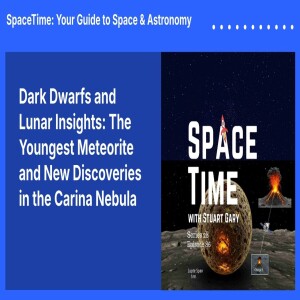
Friday Jul 18, 2025
Dark Dwarfs and Lunar Insights: The Youngest Meteorite and New Discoveries in the Carina Nebula
In this episode of SpaceTime , we explore the latest discoveries in lunar geology, the intriguing concept of dark dwarves, and the stunning features of the Carina Nebula.
The Youngest Basaltic Lunar Meteorite
Scientists have uncovered a 2.35 billion-year-old lunar meteorite, Northwest Africa 16286, which fills a significant gap in our understanding of the Moon's volcanic history. This meteorite, distinct in its chemical profile, suggests that volcanic activity on the Moon persisted longer than previously thought, unveiling new insights into its internal heat generation processes. Lead author Joshua Snape from the University of Manchester explains how this rare sample enhances our knowledge of lunar geology without the costs associated with space missions.
Hypothetical Dark Dwarfs and Dark Matter
A new study proposes the existence of hypothetical objects called dark dwarves, which could help unravel the mystery of dark matter—an invisible substance that constitutes approximately 80% of the universe's mass. Researchers suggest that these low-mass objects could interact with dark matter in ways that produce observable effects, providing a potential pathway to understand this elusive component of the cosmos. The study highlights the importance of identifying markers, such as lithium-7, to confirm the existence of dark dwarfs and advance our understanding of dark matter.
Adaptive Optics and the Carina Nebula
Using adaptive optics, astronomers have achieved unprecedented clarity in imaging the western wall of the Carina Nebula, revealing intricate structures previously hidden by dust and gas. This breakthrough allows for a deeper investigation into star formation processes in this massive stellar nursery. The enhanced images showcase how massive young stars influence their surroundings and contribute to the cycle of stellar life, offering a glimpse into the conditions that may have shaped our own solar system.
www.spacetimewithstuartgary.com (https://www.spacetimewithstuartgary.com/)
✍️ Episode References
Journal of Cosmology and Astroparticle Physics
https://www.journalofcosmology.com/ (https://www.journalofcosmology.com/)
Nature Journal
https://www.nature.com/nature (https://www.nature.com/nature)
Become a supporter of this podcast: https://www.spreaker.com/podcast/spacetime-space-astronomy--2458531/support (https://www.spreaker.com/podcast/spacetime-space-astronomy--2458531/support?utm_source=rss&utm_medium=rss&utm_campaign=rss) .
00:00 00:49 04:51 09:17 15:16 17:08
Episode link: https://play.headliner.app/episode/28150424?utm_source=youtube
No comments yet. Be the first to say something!